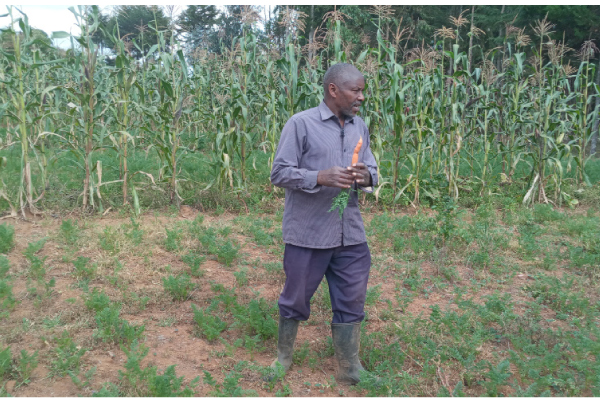Prime
How to farm during dry spell

Njoroge explains how he uses irrigation to farm throughout the year. Photo/Lominda Afedraru
What you need to know:
- Uganda’s rain-fed agriculture has progressively been constrained by frequent threats, droughts and floods.
It is early morning and a team of East African science journalists set off on a four-hour drive from Nairobi, Kenya to Nyandarua County in central Kenya on a fact finding visit.
The team arrive at Sasumua Dam with its main water source flowing from Chania River originating from the mountain ranges. Here , the situation looks dire because the dry spell is serious as seen from the looks of the agricultural initiatives from farmer fields.
Background
A quick look at the farming communities practicing agriculture in arid and semi-arid areas in Sub Saharan Africa is a huge challenge with most of the interventions done by developmental partners such as Food and Agriculture Organisation (FAO) in partnership with Ministries of Agriculture in various countries.
In most cases development partners implement solutions geared towards adoption of irrigation technology during prolonged drought periods but access water facility can be a challenge
The statistical data provided by the ministry of Agriculture in the National Irrigation Policy indicates that irrigated land produces 40 percent of global food (IFAD, 2015).
Currently, Uganda’s ratio of cultivated area under irrigation to the irrigation potential is only 0.5 percent.
This compares lowly to 3.6 percent for Tanzania and 2.0 percent for Kenya. The comfort of receiving rains to sustain two cropping seasons in a year has provided little incentive to Government to invest extensively in irrigation.
Little attention has been accorded to technological and human capacity development in irrigation.
Despite the advantages the country holds in the ease of undertaking irrigation development, the potential has not been harnessed.
Uganda’s rain-fed agriculture has progressively been constrained by frequent threats of actual occurrence of, droughts and floods.
However Ugandan farmers are not worse off than their counterparts in Kenya because we have several sources of water which farmers can tap to practice farming even during dry season.
As such Seeds of Gold got the opportunity to interact with farmers in Nyandarua as to how they are able to practice farming despite the dire situation of lack of water for the communities living in the country and below are the details.
Source of water
In Sub Saharan Africa including Uganda typical sources of agricultural water include surface water which are categorised as rivers, streams and irrigation ditches including open canals impounded water such as ponds, reservoirs and lakes.
Others are groundwater from wells, harvested rainwater, locally collected water in containers, tanks and rain barrels.
There are four main areas of water use in agriculture which include for growing of crops, through irrigation, supplying drinking water to livestock, cleaning farm buildings and animals and supplying drinking water for those who work on the farm.
Farmer experience
Phillis Wanjiru is a seasoned mixed farmer practicing agriculture on her two and half acres of land located to the main water supply Sasumua dam in Nyandarua County which she is unable to access. She grows mainly vegetables which include cabbages and kales (sukumawiki), Hass avocado, strawberry and Irish potatoes. She is also keeping two dairy cattle for milk collection which is a practice for most farmers in the area. Wanjiru contends that farming in Kenya is not easy due to water scarcity.
Wanjiru and other farmers in the county manage to farm throughout the year having been able to collect resources as group to invest in irrigation.
“After several engagements with other farmers in this county, we realised we needed water to grow more especially during drought. To achieve our goals, we had to pull resources as a group. That is how most of us managed to finance the sinking of boreholes which gives us water to irrigate our vegetables,” says Wanjiru. With the resources, each group member can access money to invest in irrigation. Wanjiru has also managed to dig wells which she uses to store harvested water during rainy season.
“I borrowed some money from the farmer’s group and I was able to purchase a 50,000 litre tank where I keep the rain water I harvest during rainy season,” says Peter Mongi Njoroge who is a mixed farmer.




